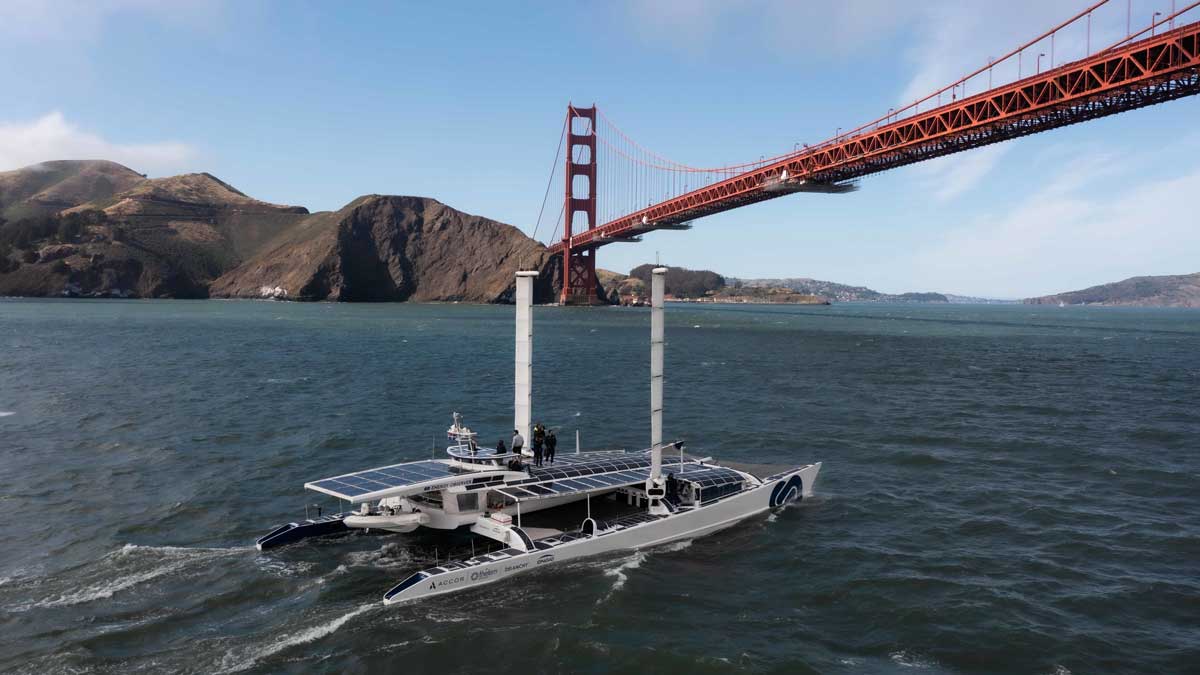It has been one year since the Energy Observer – thought to be the world’s first hydrogen-powered catamaran – commenced its journey from Saint Malo in northern Brittany to criss-cross the planet’s oceans to prove that the decarbonisation of the maritime sector is possible, with solar, wind, tidal power and hydrogen.
The solar panel-adorned catamaran has now moored at the “mecca” of electric transport and home of Tesla, San Francisco, its second US stopover after a week-long stop at Long Beach near San Diego in April.
The brain-child of sailor Victorien Erussard, an officer in the merchant navy and a competitor in renowned nautical races, the Energy Observer’s aim is to reduce carbon emissions from maritime transport by promoting the use of renewable energies.
For this purpose, Erussard transformed an old racing boat built under the supervision of skipper Mike Birch, which won the round-the-world Jules-Verne Trophy in 1994, into a “virtuous” boat.
Choosing California as a destination was not by chance: California is the only US state to have a network of more than 40 hydrogen charging stations, mainly between San Diego and San Francisco, and even as far as Lake Tahoe, with the goal of reaching 200 stations by 2022.
“It is particularly important for us to come here, in order to meet the actors of the changes that we are advocating: California has a proactive policy of using renewable energies, there is also a hydrogen highway, with numerous stations along the coast ”, Lorène Blottière, in charge of communications for the boat, was quoted as saying by French Morning (translated from French).

But the boat can also generate its own hydrogen. Covered liberally in more than 200 square metres of solar panels, some of which are double-sided to catch radiation from light reflecting off the sea’s surface, the Energy Observer is fitted with a reverse osmosis system developed by Japanese carmaker Toyota.
While hydrogen may not be the simplest solution for passenger vehicles, for applications such as aviation and maritime it has the advantage of lightness. In the case of the Energy Observer, the fuel cell system reduces the overall weight of the boat by 14 tonnes, and therefore its energy consumption.
Most of the time, the solar panels are used to power everything on board the boat but when the boat is moored, excess energy is used to create hydrogen.
The boat takes in seawater which it purifies and then electrolyses, separating the water’s elements into pure oxygen and hydrogen.
The hydrogen is then stored in eight fuel cell tanks which can store enough hydrogen for six days.
The Energy Observer can also take advantage of ocean breezes to activate its “ocean wings” – the vertical propulsion wings located on the sides of the boat – which act as sails but can also generate energy.
“In general, we use 40% solar, 40% wind and only 20% hydrogen,” Marin Jarry, second in command of the boat, was quoted as saying by French Morning.

Clean credentials of the boat notwithstanding, the planned four-year journey which commenced in March 2020 has not been without its challenges.
Just as the boat’s team was preparing to set sail, the Coronavirus started taking its toll across the globe. The pandemic altered the boat’s navigation plans but there was no question of abandoning the Energy Observer mission along the way: “We left a few days before the start of containment. As we could no longer stop in the ports that were to serve as our stopovers, our transatlantic crossing turned into a 47-day odyssey at sea, and all this under sail,” Jarry said (translated from French).
The next stop for the Energy Observer will be Hawaii, before heading to Japan for the Olympic Games. The boat will complete its round-the-world trip in three years, after having visited some fifty countries and hopes to accelerate the energy transition in transport.

Bridie Schmidt is associate editor for The Driven, sister site of Renew Economy. She has been writing about electric vehicles since 2018, and has a keen interest in the role that zero-emissions transport has to play in sustainability. She has participated in podcasts such as Download This Show with Marc Fennell and Shirtloads of Science with Karl Kruszelnicki and is co-organiser of the Northern Rivers Electric Vehicle Forum. Bridie also owns a Tesla Model Y and has it available for hire on evee.com.au.

